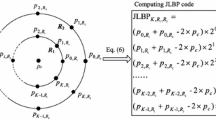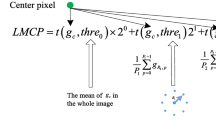Abstract
Over the year, visual texture analysis has come to be recognized as one of the most important methods in the area of medical image analysis and understanding, face description and detection, and so on. The goal of texture descriptors is to capture the general characteristic of textures such as dependency as well as invariance properties. Among all the texture descriptors, the binary pattern family of algorithms achieves a great trade of representation efficiency and complexity. This work introduces an efficient discriminative texture descriptor for visual texture classification. Its main contribution is twofold: a multiscale thresholding framework based on hierarchical adaptive local partition to binary encoding and an efficient completed local entropy binary pattern (CLEBP) descriptor. The basic completed local entropy binary pattern is extended by multiscale thresholding framework with hierarchical thresholding to capture not only microstructure local patterns but also macrostructure texture information. Such extension improves the quality and discriminative factor of texture classification. Extensive experiments on three widely used benchmark texture databases (Outex, UIUC, and KTH-TIPS) proof the efficiency of the proposed visual texture descriptor and hierarchical thresholding strategy. Compared with some classical local binary pattern variants and many state-of-the-art methods, the proposed descriptor achieves competitive and superior texture classification performance. The results prove that the proposed method is a powerful and effective texture descriptor for visual texture classification.








Similar content being viewed by others
References
Boulkenafet Z, Komulainen J, Hadid A. Face spoofing detection using colour texture analysis. IEEE Trans Inf Forensics Security. 2016;11(8):1818–30.
Zhao X, Lin Y, Heikkilä J. Dynamic texture recognition using volume local binary count patterns with an application to 2D face spoofing detection. IEEE Trans Multimedia. 2017;20(3):552–66.
Castellano G, Bonilha L, Li L, Cendes F. Texture analysis of medical images. Clin Radiol. 2004;59(12):1061–9.
Torabi M, Ardekani RD, Fatemizadeh E. Discrimination between Alzheimer's disease and control group in MR-images based on texture analysis using artificial neural network. Proc IEEE Int Conf Biomed Pharmaceutical Eng. 2006;79–83.
Wang YN, Huang JC. Texture analysis in hexagonal materials. Mater Chem Phys. 2003;81:11–26.
Akbari V, Doulgeris AP, Moser G, Eltoft T, Anfinsen SN, Serpico SB. A textural–contextual model for unsupervised segmentation of multipolarization synthetic aperture radar images. IEEE Trans Geosci Remote Sens. 2013;51(4):2442–53.
Masjedi A, Zoej MJV, Maghsoudi Y. Classification of polarimetric SAR images based on modeling contextual information and using texture features. IEEE Trans Geosci Remote Sens. 2016;54(2):932–43.
Liu L, Lao S, Fieguth P, Guo Y, Wang X, Pietikainen M. Median robust extended local binary pattern for texture classification. IEEE Trans Image Process. 2016;25(3):1368–81.
Ojala T, Pietikäinen M, Maenpää T. Multiresolution gray-scale and rotation invariant texture classification with local binary patterns. IEEE Trans Pattern Anal Mach Intell. 2002;24(7):971–87.
Liu L, Fieguth P, Pietikainen M, and Lao S. Median robust extended local binary pattern for texture classification. in Proc IEEE Int Conf Image Process (ICIP). 2015;2319–2323.
Subrahmanyam M, Maheshwari R, Balasubramanian R. Local maximum edge binary patterns: a new descriptor for image retrieval and object tracking. Signal Process. 2012;92(6):1467–79.
Murala S, Maheshwari RP, Balasubramanian R. Local tetra patterns: a new feature descriptor for content-based image retrieval. IEEE Trans Image Process. 2012;21(5):2874–86.
Ahonen T, Hadid A, Pietikäinen M. Face description with local binary patterns: application to face recognition. IEEE Trans Pattern Anal Mach Intell. 2006;28(12):2037–41.
Ahonen T, Hadid A, Pietikáinen M. Face recognition with local binary patterns. Proc Eur Conf Comput Vis. 2004; 469–481.
Tan X, Triggs B. Enhanced local texture feature sets for face recognition under difficult lighting conditions. IEEE Trans Image Process. 2010;19(6):1635–50.
Nanni L, Lumini A, Brahnam S. Local binary patterns variants as texture descriptors for medical image analysis. Artif Intell Med. 2010;49(2):117–25.
Satpathy A, Jiang X, Eng H. LBP based edge texture features for object recognition. IEEE Trans Image Process. 2014;23(5):1953–64.
Guo Z, Zhang L, Zhang D. A completed modeling of local binary pattern operator for texture classification. IEEE Trans Image Process. 2010;9(16):1657–63.
Guo Z, Zhang L, Zhang D. Rotation invariant texture classification using lbp variance (LBPV) with global matching. Pattern Recogn. 2010;43(3):706–19.
Zhao Y, Huang DS, Jia W. Completed local binary count for rotation invariant texture classification. IEEE Trans Image Process. 2012;20(10):4492–7.
Zhao Y, Jia W, Hu RX, Min H. Completed robust local binary pattern for texture classification. Neurocomputing. 2013;106(1):68–76.
Song K, Yan Y, Zhao Y, Liu C. Adjacent evaluation of local binary pattern for texture classification. J Vis Commun Image Represent. 2015;33:323–39.
Guo Z, Wang X, Zhou J, You J. Robust texture image representation by scale selective local binary patterns. IEEE Trans Image Process. 2016;25(2):687–99.
Mehta R, Egiazarian KO. Dominant rotated local binary patterns (DRLBP) for texture classification. Pattern Recogn Lett. 2016;71:16–22.
Pan ZB, Li ZY, Fan HC, Wu XQ. Feature based local binary pattern for rotation invariant texture classification. Expert Syst Appl. 2017;88:238–48.
Wang K, Bichot CE, Li Y, Li BL. Local binary circumferential and radial derivative pattern for texture classification. Pattern Recogn. 2017;67:213–29.
Shakoor M, Boostani R. Extended mapping local binary pattern operator for texture classification. Int J Pattern Recognit. 2017;31(6):1–22.
Zhang Z, Liu S, Mei X, Xiao B, Zhang L. Learning completed discriminative local features for texture classification. Pattern Recogn. 2017;67:263–75.
Yu J, Kuang Z, Zhang B, Zhang W, Lin D, Fan J. Leveraging content sensitiveness and user trustworthiness to recommend fine-grained privacy settings for social image sharing[J]. IEEE Trans Inf Forensics Secur. 2018;13(5):1317–32.
Zhang J, Yu J, Tao D. Local deep-feature alignment for unsupervised dimension reduction[J]. IEEE Trans Image Process. 2018;24(5):2420–32.
Yu J, Rui Y, Tao D. Click prediction for web image Reranking using multimodal sparse coding[J]. IEEE Trans Image Process. 2014;23(5):2019–32.
Yu J, Yang X, Gao F, et al. Deep multimodal distance metric learning using click constraints for image ranking[J]. IEEE Trans Cybern. 2016;1–11.
Thangarajah A, Jonathan WQ, Hui Z. Effect of fusing features from multiple DCNN architectures in image classification[J]. IET Image Process. 2018;12(7):1102–10.
Akilan T, Wu QMJ, Safaei A, Jiang W. A late fusion approach for harnessing multi-CNN model high-level features. 2017 IEEE International Confere nce on Systems. 2017; 1–8.
Lin TY and Maji S. Visualizing and understanding deep texture representations. in Proc IEEE Conf Comput Vis Pattern Recogn. 2016; 2791–2799.
Yu J, Tao D, Wang M, Rui Y. Learning to rank using user clicks and visual features for image retrieval[J]. IEEE Transactions on Cybernetics. 2015;45(4):767–79.
Yu J, Rui Y, Tang YY, Tao D. High-order distance-based multiview stochastic learning in image classification[J]. IEEE Transactions on Cybernetics. 2014;44(12):2431–42.
Zhong G, Yan S, Huang K, Cai Y, Dong J. Reducing and stretching deep convolutional activation features for accurate image classification[J]. Cogn Comput. 2018;10(1):179–86.
Srikanth V, Neerja M, Chakravarthy NB, et al. 3D local spatio-temporal ternary patterns for moving object detection in complex scenes[J]. Cogn Comput. 2019;11(1):18–30.
Toprak S, Nicolás N-G, Wermter S. Evaluating integration strategies for visuo-haptic object recognition[J]. Cogn Comput. 2018;10(3):408–25.
Yu J, Zhu C, Zhang J, et al. Spatial pyramid-enhanced NetVLAD with weighted triplet loss for place recognition[J]. IEEE Trans Neural Netw Learn Syst. 2019;1–14.
Zrira N, Khan HA, Bouyakhf EH. Discriminative deep belief network for indoor environment classification using global visual features[J]. Cogn Comput. 2018;10(3):437–53.
Hong C, Yu J, Chen X, et al. Image-based 3D human pose recovery with locality sensitive sparse retrieval. in Proc. IEEE International Conference on Systems. 2013; 1–6.
Hong C, Yu J, Wan J, Tao D, Wang M. Multimodal deep autoencoder for human pose recovery[J]. IEEE Trans Image Process. 2015;24(12):5659–70.
Yang ZX, Tang L, Zhang K, Wong PK. Multi-view CNN feature aggregation with ELM auto-encoder for 3D shape recognition[J]. Cogn Comput. 2018;10(6):908–21.
Li J, Zhang Z, He H. Hierarchical convolutional neural networks for EEG-based emotion recognition[J]. Cogn Comput. 2017;10(2):368–80.
Ren CX, Lei Z, Dai DQ, Li SZ. Enhanced local gradient order features and discriminant analysis for face recognition. IEEE Trans Image Process. 2016;22(5):2656–69.
Huang W, Yin H. Robust face recognition with structural binary gradient patterns. Pattern Recogn. 2017;68:126–40.
Ojala T, Maenpaa T, Pietikainen M, Viertola J, Kyllonen J, and Huovinen S. Outex – new framework for empirical evaluation of texture analysis algorithms. In Proc IEEE Int Conf Pattern Recognit (ICPR). 2002; 701–706.
Dana KJ, Van Ginneken B, Nayar SK, Koenderink JJ. Reflection and texture of real-word surfaces. ACM Trans Graph. 1999;18(1):1–34.
Hayman E, Caputo B, Fritz M, and Eklundh J. On the significance of real-world conditions for material classification. In Proc Eur Conf Comput Vis. 2004; 253–266.
Liu L, Long Y, Fieguth PW, Lao S, Zhao G. BRINT: binary rotation invariant and noise tolerant texture classification. IEEE Trans Image Process. 2014;23(7):3071–84.
Zhao Y, Wang R G , Wang W M , et al. Local quantization code histogram for texture classification. Neurocomputing. 2016; 354–364.
Funding
The paper is funded by the National Natural Science Foundation of China (Grant No. 61701134, 51,809,056), the National Key Research and Development Program of China (Grant No. 2016YFF0102806), and the Natural Science Foundation of Heilongjiang Province, China (Grant No. F2017004).
Author information
Authors and Affiliations
Corresponding author
Ethics declarations
Conflict of Interests
The author declares that she has no conflict of interest.
Ethical Approval
This article does not contain any studies with human participants or animals performed by any of the authors.
Additional information
Publisher’s Note
Springer Nature remains neutral with regard to jurisdictional claims in published maps and institutional affiliations.
Rights and permissions
About this article
Cite this article
Xu, X., Li, Y. & Wu, Q.M.J. A Multiscale Hierarchical Threshold-Based Completed Local Entropy Binary Pattern for Texture Classification. Cogn Comput 12, 224–237 (2020). https://doi.org/10.1007/s12559-019-09673-9
Received:
Accepted:
Published:
Issue Date:
DOI: https://doi.org/10.1007/s12559-019-09673-9




